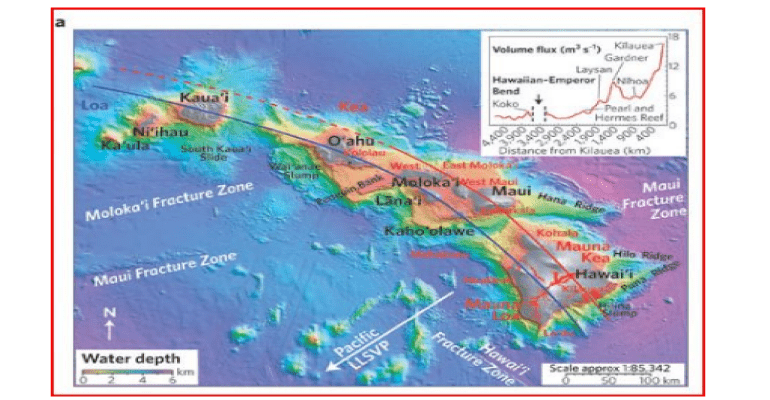
The Hawaiian Islands sit over the largest and most productive mantle plume on earth, a hotspot that has been active for at least 80 million years and extends deep into the mantle, possibly to the core-mantle boundary. As the Pacific tectonic plate travels northwest over this hotspot (at about 4 inches per year), the magma punches through the crust to build volcanos and volcanic islands.
Currently the hotspot sits under the big island of Hawaii and during the last 5 million years has produced two volcanic edifices, Mauna Loa on the southwest and Mauna Kea on the northeast. Although these volcanos are just 25 miles apart, their lavas differ geochemically and isotopically. As the tectonic plate has moved to the northwest, two parallel tracks of geochemically different lavas and volcanos have been built.
Weiss et al. explain, “Mantle plumes and their related hotspot volcanism constitute one of the main processes affecting the cooling and internal differentiation of the Earth’s mantle and crust. The mantle plumes form in response to cooling of the Earth’s core. Whereas plume heads contribute huge volumes of lava to the Earth’s surface over short periods of time, plume tails create chains of volcanoes, some extending for thousands of kilometers.” Map from Weiss et al.
Weiss et al. suggest “the Hawaiian mantle plume, when projected into the deep mantle, overlies the boundary between typical Pacific lower mantle and a sharply defined layer of apparently different material.” And, “the geochemical differences between the Kea and Loa trends reflect preferential sampling of these two distinct sources of deep mantle material.” Huang et al. note that the Samoan and Marquesas island chain show a similar duality.
Seismological studies infer that the Hawaiian mantle plume overlies the northeast edge of a “‘large low-shear-velocity province” which is “an anomalously dense, compositionally distinct region, steep-sided and several hundred kilometers high.” Although the two volcanos, Mauna Loa and Mauna Kea are just 25 miles apart, they straddle the boundary of this structure that lies 1,700 miles below the surface and therefore sample different parts of the mantle.
Differences in composition of these two areas may reflect initial differentiation of the Earth’s mantle during solidification as well as local contributions from subduction of oceanic and continental crust.
The magma plume is about 60 miles in diameter and a given spot will take about one million years to cross it.
This article reprinted from Wryheat.
References:
- Huang, S., Hall, P.S., and Jackson, M.G., 2011, Geochemical zoning of volcanic chains associated with Pacific hotspots, Nature Geoscience 4,874–878. [Link to full paper]
- Weis, D., Garcia, M.O., Rhodes, J.M. Jellinek, M., and Scoates, J.S., 2011, Role of the deep mantle in generating the compositional asymmetry of the Hawaiian mantle plume, Nature Geoscience4,831–838. [Link to full paper]
See also:
